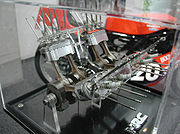
Honda NR
Encyclopedia


Honda
is a Japanese public multinational corporation primarily known as a manufacturer of automobiles and motorcycles.Honda has been the world's largest motorcycle manufacturer since 1959, as well as the world's largest manufacturer of internal combustion engines measured by volume, producing more than...
NR (New Racing) V-four
V4 engine
A V4 engine is a V form engine with four cylinders and three main bearings.-Automobile use:Lancia produced several narrow-angle V4 engines from the 1920s through 1960s for cars like the Lambda, Augusta, Artena, Aprilia, Ardea, Appia, and Fulvia....
motorcycle
Motorcycle
A motorcycle is a single-track, two-wheeled motor vehicle. Motorcycles vary considerably depending on the task for which they are designed, such as long distance travel, navigating congested urban traffic, cruising, sport and racing, or off-road conditions.Motorcycles are one of the most...
engine series started in 1979 with the 500cc NR500 Grand Prix
Grand Prix motorcycle racing
Road Racing World Championship Grand Prix is the premier championship of motorcycle road racing currently divided into three distinct classes: 125cc, Moto2 and MotoGP. The 125cc class uses a two-stroke engine while Moto2 and MotoGP use four-stroke engines. In 2010 the 250cc two-stroke was replaced...
racer that used oval pistons. This was followed during the 1980s by a 750cc endurance racer version known as the NR750. The oval piston
Piston
A piston is a component of reciprocating engines, reciprocating pumps, gas compressors and pneumatic cylinders, among other similar mechanisms. It is the moving component that is contained by a cylinder and is made gas-tight by piston rings. In an engine, its purpose is to transfer force from...
concept allowed for eight valves per cylinder
Cylinder (engine)
A cylinder is the central working part of a reciprocating engine or pump, the space in which a piston travels. Multiple cylinders are commonly arranged side by side in a bank, or engine block, which is typically cast from aluminum or cast iron before receiving precision machine work...
which generated more power due to the increased air/fuel mixture throughput and compression. In 1992 Honda produced around 300 street versions of a 750cc model, the NR (often mistakenly referred to as the NR750), with a 90-degree V angle. Whereas the NR500 had used an oval piston with straight sides, the road going NR750 used an elliptical piston with curved long sides. The bike became the most expensive production bike at the time when it was selling for $50,000 and with the rarity, nowadays they rarely change hands.
Development
The origins of the 'NR' series of motorcycles lie in Honda's return to Grand Prix motorcycle racingGrand Prix motorcycle racing
Road Racing World Championship Grand Prix is the premier championship of motorcycle road racing currently divided into three distinct classes: 125cc, Moto2 and MotoGP. The 125cc class uses a two-stroke engine while Moto2 and MotoGP use four-stroke engines. In 2010 the 250cc two-stroke was replaced...
in the late 1970s following an absence since their highly successful participation in the 1960s. During the absence of Honda, Grand Prix racing had come to be dominated by two-stroke
Two-stroke cycle
A two-stroke engine is an internal combustion engine that completes the process cycle in one revolution of the crankshaft...
machines that could easily attain a higher specific output than a four-stroke
Four-stroke cycle
A four-stroke engine, also known as four-cycle, is an internal combustion engine in which the piston completes four separate strokes—intake, compression, power, and exhaust—during two separate revolutions of the engine's crankshaft, and one single thermodynamic cycle.There are two...
equivalent. Honda had long preferred to concentrate on four-stroke development and therefore decided to produce such a machine to challenge their Japanese rivals.
To achieve this aim Honda could have looked to follow their 1960's practice of increasing the number of cylinders to produce more power. However, Grand Prix rules at the time required a configuration with maximum of four combustion chambers. Honda engineers therefore came up with the highly innovative solution of constructing a 'V8' engine in the form of a four cylinder. This was achieved by designing an oval piston that allowed a total of 8 valves per cylinder, and connecting two con-rods to each piston. Such a configuration led to almost unprecedented complexity in terms of engine design, with 32 valves and eight con-rods incorporated into the dimensions of a regular four cylinder motorcycle engine.
Development and testing of the new engine proved fraught with difficulty (prompting some motorcycle journalists of the time to comment that NR meant "Never Ready") but Honda eventually succeeded in meeting the original performance criteria for the engine. The final 500cc race version was capable of developing approximately 130 bhp at over 20,000rpm. However, this rarely translated into success on the track for the NR500, and Honda subsequently redirected its Grand Prix campaign in the form of the NS500
Honda NS500
The Honda NS500 is a 500cc Grand Prix racing motorcycle of the early 1980s, powered by a two-stroke V3 engine. Created as a replacement for the innovative but unsuccessful four-stroke NR500, the bike went against Honda's preference for four-stroke machines but proved very effective and quickly won...
two-stroke machine.
In 1983/84, a 250cc V-twin using a supercharger and the 8-valve oval piston technology was developed but never seen in public.
The oval piston concept continued in the NR750 endurance bike, which made a brief appearance during the 1980s. Finally the technology was transferred to the road, at least on a limited basis, in the bike simply referred to as the 'NR'. One of the most expensive road motorcycles yet offered for sale, a limited number of the NR models was sold in 1992 with a 750cc version of the engine capable of developing approximately 125 bhp at 14,000rpm in standard form. Although a heavy machine by modern standards, it incorporated a range of technologies and design features that have now appeared on more regular models.
Concept
In 2008 Cologne Motorcycle Show, Honda unveiled a V4 Concept Model to celebrate the company's 60th anniversary.http://blogs.edmunds.com/straightline/2008/10/honda-v4-motorcycle-concept-with-trick-engine.htmlExternal links
- Honda NR750 RC40 model information

